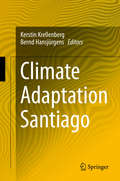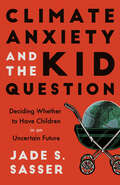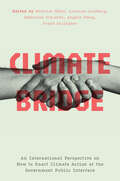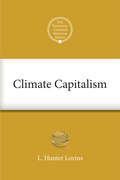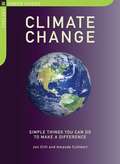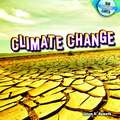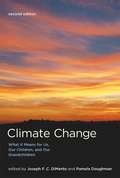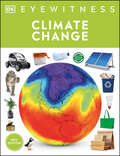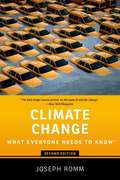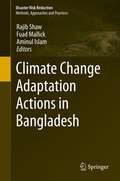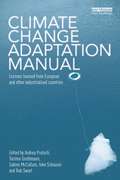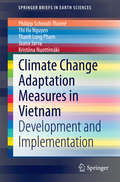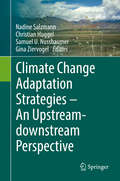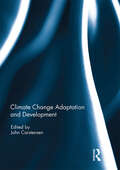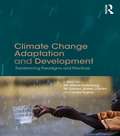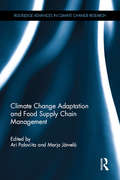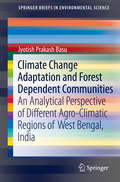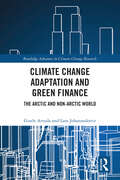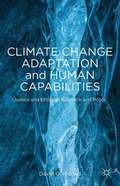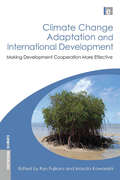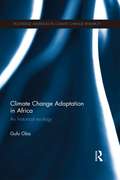- Table View
- List View
Climate Adaptation Santiago
by Bernd Hansjürgens Kerstin KrellenbergThis book addresses the complexity of urbanization, impacts of climate change and climate change adaptation for the metropolitan region of Santiago de Chile, with a special focus on the most pressing issues of natural hazards, water and energy supply. The book exemplifies a conceptual approach for the development of adaptation measures, their evaluation and implementation in a decision support framework at the science-policy interface. It builds on scientific analyses of social and natural scientists, a participatory process with local authorities and a mutual learning network between large agglomerations in Latin America. The book is written for scholars of urban management, climate change, planning, governance and hazard research, as well as practitioners in local, regional and international organizations concerned with climate change, climate change impacts, and adaptation in metropolitan regions. While the regional focus is on Latin America the concepts and lessons learned are applicable and relevant to megacities around the world.
Climate Anxiety and the Kid Question: Deciding Whether to Have Children in an Uncertain Future
by Jade SasserThe first book-length exploration of climate-driven reproductive anxiety that places race and social justice at the center. Eco-anxiety. Climate guilt. Pre-traumatic stress disorder. Solastalgia. The study of environmental emotions and related mental health impacts is a rapidly growing field, but most researchers overlook a closely related concern: reproductive anxiety. Climate Anxiety and the Kid Question is the first comprehensive study of how environmental emotions influence whether, when, and why people today decide to become parents—or not. Jade S. Sasser argues that we can and should continue to create the families we desire, but that doing so equitably will require deep commitments to social, reproductive, and climate justice. Climate Anxiety and the Kid Question presents original research, drawing from in-depth interviews and national survey results that analyze the role of race in environmental emotions and the reproductive plans young people are making as a result. Sasser concludes that climate emotions and climate justice are inseparable, and that culturally appropriate mental and emotional health services are a necessary component to ensure climate justice for vulnerable communities.
Climate Bridge: An International Perspective on How to Enact Climate Action at the Government Public Interface
by Laurel V. HankinsClimate change is creating new challenges for spatial and environmental planning on both sides of the Atlantic. Planning and policy must balance moderating climate change impact from rising temperatures, extreme precipitation, and sea level rise with social equity and environmental justice. Climate Bridge compares New Jersey and the German Ruhr region to build an international perspective on how to enact climate action at the government-public interface. The book grew from fifteen years of collaboration between scholars in New Jersey and Germany through summer programs, a landscape architecture design studio, internships for Rutgers University students, and joint publications. Notably, settlement patterns and brownfield issues reveal similarities between the underserved in both regions. The first section compares international environmental planning approaches and outlines different approaches to common problems. The second section presents case studies that highlight adaptation strategies for uncertainties caused by climate change. Finally, the closing section reminds us of our dependence on ecological systems for physical, mental, and emotional well-being. Contributors to this landmark volume include planners, designers, scholars, public administrators, and decision-makers on both sides of the Atlantic. Together, the chapters bring interdisciplinary approaches and diverse perspectives to the environmental, economic, political, and social dimensions of planning and design in the context of climate change.
Climate Capitalism
by L. Hunter Lovins Eban GoodsteinOn October 5, 2011, L. Hunter Lovins participated in The National Climate Seminar, a series of webinars sponsored by Bard College's Center for Environmental Policy. The online seminars provide a forum for leading scientists, writers, and other experts to talk about critical issues regarding climate change. The series also opens a public conversation, inviting participants to ask questions and contribute their own thoughts. Lovins is President and founder of Natural Capitalism Solutions (NCS / www.natcapsolutions.org). NCS works with businesses, governments, and civil society to develop practices that are sustainable for both people and the environment. Her lecture focused on ways that the United States can pull itself out of the current recession, while preserving natural and human capital. This E-ssentialis an edited version of Lovins' talk and the subsequent question and answer session. While some material has been cut and some language modified for clarity, the intention was to retain the substance of the original discussion.
Climate Capitalism
by Peter Newell Matthew PatersonConfronting climate change is now understood as a problem of 'decarbonising' the global economy: ending our dependence on carbon-based fossil fuels. This book explores whether such a transformation is underway, how it might be accelerated, and the complex politics of this process. Given the dominance of global capitalism and free-market ideologies, decarbonisation is dependent on creating carbon markets and engaging powerful actors in the world of business and finance. Climate Capitalism assesses the huge political dilemmas this poses, and the need to challenge the entrenched power of many corporations, the culture of energy use, and global inequalities in energy consumption. Climate Capitalism is essential reading for anyone wanting to better understand the challenge we face. It will also inform a range of student courses in environmental studies, development studies, international relations, and business programmes.
Climate Change
by Jon Clift Amanda CuthbertYou know that the ice caps are melting, the seasons are changing, sea levels are rising, storms are on the increase, but what can you do about it? Plenty! This book puts the power back into your hands in the face of the doom and gloom of climate change. You don't have to wait for someone else to sort it out; rather than worry and feel helpless, you can get up and do something. "Climate Change: Simple Things You Can Do to Make a Difference" is packed with ideas for action, from simple everyday things that cost nothing to bigger projects that involve more time and money. For example: Get on your bike bull; Buy local food bull; Turn off your TV bull; Insulate your attic bull; Recycle and compost bull; Take the train bull; Turn down the heat bull; Install solar panels Do your part and protect the planet for today and tomorrow.
Climate Change
by Jason D. NemethOur home planet's climate has gone through tremendous changes during its history. This fascinating book discusses these changes, explains the processes that drove them, and describes the methods scientists use to learn about the history of Earth's climate. The volume also addresses the kinds of climate changes happening today and clarifies how these differ from changes that occurred in the past. The book's easy-to-follow language will make this complex topic easy for young readers to digest.
Climate Change
by Jonathan CowieThe second edition of this acclaimed text has been fully updated and substantially expanded to include the considerable developments (since publication of the first edition) in our understanding of the science of climate change, its impacts on biological and human systems, and developments in climate policy. Written in an accessible style, it provides a broad review of past, present and likely future climate change from the viewpoints of biology, ecology, human ecology and Earth system science. It will again prove to be invaluable to a wide range of readers, from students in the life sciences who need a brief overview of the basics of climate science, to atmospheric science, geography, geoscience and environmental science students who need to understand the biological and human ecological implications of climate change. It is also a valuable reference text for those involved in environmental monitoring, conservation and policy-making.
Climate Change
by Pamela Doughman Joseph F.C. DiMentoMost of us are familiar with the term climate change but few of us understand the science behind it. We don't fully comprehend how climate change will affect us, and for that reason we might not consider it as pressing a concern as, say, housing prices or unemployment. This book explains the scientific knowledge about global climate change clearly and concisely in engaging, nontechnical language, describes how it will affect all of us, and suggests how government, business, and citizens can take action against it. This completely revised and updated edition incorporates the latest scientific research and policy initiatives on climate change. It describes recent major legislative actions, analyzes alternative regulatory tools including new uses of taxes and markets, offers increased coverage of China and other developing nations, discusses the role of social media in communicating about climate change, and provides updated assessments of the effects of climate change. The book first explains the basic scientific facts about climate change and its global impact. It discusses the nature of scientific consensus and the strong consensus of mainstream science on climate change. It then explores policy responses and corporate actions in the United States and the rest of the world, discusses how the communication of climate change information by journalists and others can be improved, and addresses issues of environmental justice -- how climate change affects the most vulnerable populations and regions. We can better tackle climate change, this book shows us, if we understand it.
Climate Change (DK Eyewitness)
by John Woodward DKBecome an eyewitness to the world&’s climate emergency and learn what we can do about it.Get the facts about how our planet&’s climate is changing and what the consequences will be. This essential guide explores Earth&’s climate, past and present, giving you the facts and figures behind one of today&’s most urgent issues, and investigates what we can all do to make a difference.DK Eyewitness Climate Change explains why human activities are making the planet heat up –and how we know for sure that this is the case. This global warming book explores the effects of the changing climate, from more frequent hurricanes and wildfires to melting ice caps and rising sea levels. It shows how scientists predict how the climate will change in the future, and what actions we can all take to combat climate change.Loved and trusted for over 30 years, Eyewitness has a new look and even more content:• A bite-sized formula of text with images that kids love!• Fully revised and fact-checked by subject specialists• Packed with facts, infographics, statistics, and timelines• Updated with brand new eyewitness accounts from experts in the fieldEyewitness Climate Change uses a groundbreaking visual layout that makes learning fun for kids aged 9-12. Packed with photographs, facts, and statistics that offer a unique &“eyewitness&” view of the dramatic changes that are affecting the weather, the environment, and the way we lead our lives.Eyewitness content approved by -ologists!DK&’s Eyewitness kids books are updated and fact-checked by subject specialists, with brand new first-hand eyewitness accounts throughout from experts in the field. A best-selling series known and trusted for generations, with a fresh new look and up-to-date content. What will you Eyewitness next?Discover more about the world&’s most extreme weather phenomena with Eyewitness Hurricane & Tornado or dive deep into the ocean with some of the most amazing sea creatures with Eyewitness Ocean. Do you think you&’ve found your topic of interest? DK has even more climate change books for kids and adults alike find them all by searching for &“DK climate change books&”.
Climate Change (What everyone needs to Know)
by Joseph RommThe essential primer on what will be the defining issue of our time, Climate Change: What Everyone Needs to Know is a clear eyed overview of the science, conflicts, and implications of our warming planet. <p><p> From Joseph Romm, Chief Science Advisor for National Geographic's Years of Living Dangerously series and one of Rolling Stone's "100 people who are changing America," Climate Change offers user friendly, scientifically rigorous answers to the most difficult (and commonly politicized) questions surrounding what climatologist Lonnie Thompson has deemed "a clear and present danger to civilization." <p> New questions about climate change addressed in this guide include: <p> · Analysis of the Paris climate agreement, including the United States' withdrawal <p> · Examines implications of the clean energy revolution, from solar and wind power to batteries and electric cars <p> · The latest on climate science, including updates on efforts to stem or slow climate change <p> · Insights into what Donald Trump's presidency means for climate action in the US and internationally <p> As the global response to climate change continues to evolve, Climate Change: What Everyone Needs to Know offers smart, unbiased answers to the most difficult questions in an area dogged by misunderstanding and politicization.
Climate Change 2013 The Physical Science Basis
by Thomas F. Stocker Thomas F. Stocker Dahe Qin Gian-Kasper Plattner Melinda M.B. Tignor Simon K. Allen Judith Boschung Alexander Nauels Yu Xia Vincent Bex Pauline M. Midgley Dahe Qin Gian-Kasper Plattner Melinda M.B. Tignor Simon K. Allen Judith Boschung Alexander Nauels Yu Xia Vincent BexThis latest Fifth Assessment Report of the Intergovernmental Panel on Climate Change (IPCC) will again form the standard scientific reference for all those concerned with climate change and its consequences, including students and researchers in environmental science, meteorology, climatology, biology, ecology and atmospheric chemistry. It provides invaluable material for decision makers and stakeholders: international, national, local; and in all branches: government, businesses, and NGOs. This volume provides: • an authoritative and unbiased overview of the physical science basis of climate change; • a more extensive assessment of changes observed throughout the climate system than ever before; • new dedicated chapters on sea-level change, biogeochemical cycles, clouds and aerosols, and regional climate phenomena; • a more extensive coverage of model projections, both near-term and long-term climate projections; • a detailed assessment of climate change observations, modelling, and attribution for every continent; • a new comprehensive Atlas of Global and Regional Climate Projections for 35 regions of the world.
Climate Change Adaptation Actions in Bangladesh (Disaster Risk Reduction)
by Rajib Shaw Aminul Islam Fuad MallickThe book outlines the climate change adaptation (CCA) actions in Bangladesh drawing examples and lessons from different projects and programs in the country. The content is based on a selection of available documents, a consultative workshop with the academicians from different universities undertaking higher education on disaster risk reduction and climate change adaptation, and the editors' own knowledge and experience in the field. The book has four parts. Part I gives the details of climate change impacts, providing the scenarios, negotiations, and specific impacts on sea-level rise and the health sectors. Part II focuses on climate change strategy and action plans. Part III covers socio-economic impacts in terms of economic and environmental costs. Part IV focuses on adaptive actions for agriculture, livelihoods, and integrated approaches in agriculture and fisheries. Part V deals with climate-change governance issues. The primary target groups for this book are students and researchers in the fields of environment, disaster risk reduction, and climate change studies. The book will provide them with a good idea of the current trend of research in the field and will furnish basic knowledge on this important topic in Bangladesh. Another target group comprises practitioners and policy makers, who will be able to apply collective knowledge to policy and decision making.
Climate Change Adaptation Manual: Lessons learned from European and other industrialised countries
by Rob Swart Andrea Prutsch Torsten Grothmann Sabine McCallum Inke SchauserDue to the lack of success in climate change mitigation efforts, the importance of adaptation is becoming more and more apparent and is now one of the main imperatives of international research and action. However, research on adaptation is mostly not directly applicable to adaptation policy or practice, leaving a gap between scientific results and practical advice for decision makers and planners. This book seeks to address this problem and bridge the gap and should provide readers with practical and applicable information on climate change adaptation. Following an introduction, the book is organised into four main sections, each reflecting an essential component in the adaptation process. Climate change adaptation is an emerging subject area and has gained increased political and academic attention within the last decade. Whereas most books in the field focus on adaptation in developing countries, this volume provides an examination of predominantly European policy and offers inter-disciplinary insight into cutting edge knowledge and lessons learnt in a relatively new field of implementation.
Climate Change Adaptation Measures in Vietnam: Development and Implementation (SpringerBriefs in Earth Sciences)
by Philipp Schmidt-Thomé Thi Ha Nguyen Thanh Long Pham Jaana Jarva Kristiina NuottimäkiThis book describes the iterative steps that were successfully undertaken to develop adaptation measures to climate change in two Vietnamese provinces. The methodology used to develop the scientific basis and the societal agreement of the need to adapt to climate change is applicable also to other regions in Vietnam, Asia and worldwide. The uncertainties of climate change models make it difficult to justify investments to finance protection from uncertain impacts. Setting out with the projected climate change impacts in Vietnam, which is one of the most vulnerable countries to climate change, the book describes a methodological approach to assess and evaluate local vulnerabilities of natural resources to climate change and socio-economic impacts, engaging local stakeholders in the development of locally acceptable and economically feasible adaptation measures. The methodological approach to understand the vulnerabilities and to develop climate change adaptation measures was scenario workshops that supported the communication between scientists and stakeholders. The development of climate change adaptation strategies is nearly state-of-the-art in many countries, but often there is still a large step towards implementing climate change adaptation measures on the local level. The challenge in the development of adaptation measures lies in their acceptability by local stakeholders and decision makers. Climate change adaptation measures also usually demand investments. To understand potential future risks the communication methodology was to first get a good understanding of the natural resources (mainly surface and groundwater) and their potential vulnerabilities (current and future). This was followed by developing a common understanding of current risk patterns, as well as underlying vulnerabilities and hazards. Socio-economic developments have an equally strong, and in the short term mostly even stronger, impact on the living environment and natural resources as long-term climate change impacts. The scenario workshops developed a holistic approach on current and potential future risk patterns, with a special focus on surface and groundwater quantities and qualities, natural hazards and sea level rise. Land-use planning was identified as playing a decisive role in minimizing current and future risks. Finally, first adaptation measures for two Vietnamese provinces were developed and shall be implemented over the next years. The methodology that led to these adaptation measures shall be applied in other Vietnamese provinces.
Climate Change Adaptation Strategies – An Upstream-downstream Perspective: An Upstream-downstream Perspective
by Christian Huggel Nadine Salzmann Samuel U. Nussbaumer Gina ZiervogelClimate change and the related adverse impacts are among the greatest challenges facing humankind during the coming decades. Even with a significant reduction of anthropogenic greenhouse gas emissions, it will be inevitable for societies to adapt to new climatic conditions and associated impacts and risks. This book offers insights to first experiences of developing and implementing adaptation measures, with a particular focus on mountain environments and the adjacent downstream areas. It provides a comprehensive 'state-of-the-art' of climate change adaptation in these areas through the collection and evaluation of knowledge from several local and regional case studies and by offering new expertise and insights at the global level. As such, the book is an important source for scientists, practitioners and decision makers alike, who are working in the field of climate change adaptation and towards sustainable development in the sense of the Paris Agreement and the Agenda 2030.
Climate Change Adaptation and Development
by John CarstensenClimate change is real and it is man-made. We have put so many greenhouse gas pollutants into the atmosphere that we will see significant and long-term change that we need to adapt and adjust to. It is important for development practitioners to understand these impacts and the challenge of how and when to adapt to climate change.There are plenty of grim presentations of what the extremes of the possible climate scenarios will throw at us over the next 100 years, but not all change will be disastrous; some change will be beneficial, but much of the change will happen at an unprecedented rate that will require the best possible analysis and understanding of how and when we should adapt to climate change.This is important for development practitioners as we invest in ensuring that poverty is reduced and eliminated and the well-being of everyone is improved. Many countries and communities around the world are vulnerable to the impacts of climate change, but developing economies may on one hand be less resilient to the impact, but could on the other hand be in a better position to make their development climate smart by making the most efficient use of their economic resources.The chapters in this book shine a light on the complexity and the multi-dimensional aspects of climate change adaptation. They gather some of the experiences of addressing climate change impacts in a development context. This book was previously published as a special issue of Development in Practice.
Climate Change Adaptation and Development: Transforming Paradigms and Practices (Climate And Development Ser.)
by Karen O'Brien Tor Håkon Inderberg Siri Eriksen Linda SygnaClimate change poses multiple challenges to development. It affects lives and livelihoods, infrastructure and institutions, as well as beliefs, cultures and identities. There is a growing recognition that the social dimensions of vulnerability and adaptation now need to move to the forefront of development policies and practices. This book presents case studies showing that climate change is as much a problem of development as for development, with many of the risks closely linked to past, present and future development pathways. Development policies and practices can play a key role in addressing climate change, but it is critical to question to what extent such actions and interventions reproduce, rather than address, the social and political structures and development pathways driving vulnerability. The chapters emphasise that adaptation is about much more than a set of projects or interventions to reduce specific impacts of climate change; it is about living with change while also transforming the processes that contribute to vulnerability in the first place. This book will help students in the field of climate change and development to make sense of adaptation as a social process, and it will provide practitioners, policymakers and researchers working at the interface between climate change and development with useful insights for approaching adaptation as part of a larger transformation to sustainability.
Climate Change Adaptation and Food Supply Chain Management (Routledge Advances in Climate Change Research)
by Marja Järvelä Ari PaloviitaThe success of the entire food supply chain depends on the prosperity of farms and local communities. The direct climate change risks faced by the agricultural sector are therefore also risks to businesses and food supply chains. Hence the importance of resilience at farm level, community level and business level when looking at food supply chain policy and management. Climate Change Adaptation and Food Supply Chain Management highlights the issue of adaptation to climate change in food supply chains, the management and policy implications and the importance of supply chain resilience. Attention is given to each phase of the supply chain: input production, agriculture, food processing, retailing, consumption and post-consumption. European case studies demonstrate the vulnerabilities of contemporary food supply chains, the opportunities and competitive advantages related to climate change, and the trans-disciplinary challenges related to successful climate adaptation. The authors argue for a redefinition of the way food supply chains are operated, located and coordinated and propose a novel approach enhancing climate-resilient food supply chain policy and management. This book will be of interest to students, researchers, practitioners and policymakers in the field of climate adaptation and food supply chain management and policy.
Climate Change Adaptation and Forest Dependent Communities: An Analytical Perspective of Different Agro-Climatic Regions of West Bengal, India (SpringerBriefs in Environmental Science)
by Jyotish Prakash BasuThis book addresses the livelihood impacts of climate change, vulnerability and adaptation measures on the forest dependent communities of India. Research presented here focuses on three different agro-climatic areas of West Bengal, namely the coastal Sundarban, the drought-prone region and the mountainous region. Readers will discover the main climate induced vulnerabilities that affect livelihoods of forest communities, understand how to evaluate the expected impacts of climate change at different levels under different climate change scenarios, and be able to assess and measure the implied major social, environmental and economic impacts. Particular attention is also given to the role of the Indian governmental policy (including national forest policy of 1988) to reduce climate-related vulnerabilities. Chapters also highlight two main approaches to vulnerability assessment in socio-ecological systems. The first is the impact-based approach, which assesses the potential impacts of climate change on forest dependent people. The second is the vulnerability-based approach, which assesses social sensitivity and adaptive capacity to respond to stresses. Development practitioners, government implementing agencies, and researchers in environmental science and policy will find this book appealing.
Climate Change Adaptation and Green Finance: The Arctic and Non-Arctic World (Routledge Advances in Climate Change Research)
by Gisele Arruda Lara JohannsdottirThis book presents specific case studies of climate finance in the Arctic and examines how the green revolution could be a game changer in this sensitive region. Bringing together contributions from a range of experts in the field, Climate Change Adaptation and Green Finance assesses the costs of inaction versus the costs of action based on case study examples of climate finance and sustainable investment in the Arctic region. The authors draw on data from the Sixth Assessment Report published by the Intergovernmental Panel on Climate Change and respond with a solutions-based framework. This is developed around the notion of a new, carbon-neutral economy in the Arctic and presents methods for unlocking carbon finance and long-term climate investment in the region, such as finance for Arctic entrepreneurs and resilient sustainable investment structures. This volume also looks at the role of finance in meeting the United Nations Sustainable Development Goals and the ways in which innovation in investment will help shape the future of the Arctic. Climate Change Adaptation and Green Finance will be of great interest to students and scholars of climate change, sustainable finance and sustainable business
Climate Change Adaptation and Green Finance: The Arctic and Non-Arctic World (Routledge Advances in Climate Change Research)
by Gisele Arruda Lara JohannsdottirThis book presents specific case studies of climate finance in the Arctic and examines how the green revolution could be a game changer in this sensitive region.Bringing together contributions from a range of experts in the field, Climate Change Adaptation and Green Finance assesses the costs of inaction versus the costs of action based on case study examples of climate finance and sustainable investment in the Arctic region. The authors draw on data from the Sixth Assessment Report published by the Intergovernmental Panel on Climate Change and respond with a solutions-based framework. This is developed around the notion of a new, carbon-neutral economy in the Arctic and presents methods for unlocking carbon finance and long-term climate investment in the region, such as finance for Arctic entrepreneurs and resilient sustainable investment structures. This volume also looks at the role of finance in meeting the United Nations Sustainable Development Goals and the ways in which innovation in investment will help shape the future of the Arctic. Climate Change Adaptation and Green Finance will be of great interest to students and scholars of climate change, sustainable finance, and sustainable business.
Climate Change Adaptation and Human Capabilities
by David O. KronlidClimate Change Adaptation and Human Capabilities explores learning, health, mobility, and play as climate capabilities and produces new insights into the depth of climate change impact on social life.
Climate Change Adaptation and International Development: Making Development Cooperation More Effective
by Masato Kawanishi Ryo FujikuraClimate change impacts upon the world's poorest most heavily. It is therefore essential that international development initiatives focus on improving the ability of developing countries to adapt to the effects of climate change. This book, a product of research by the JICA-RI (Research Institute of the Japan International Cooperation Agency), examines climate change adaptation from the perspective of development cooperation in order to provide useful lessons for those engaged in research, policy and practice in this vital area. In this book the editors have brought together a wide range of case studies from across Africa and Asia, covering urban and rural areas and different sectors including water, agriculture and disaster management, in order to examine the following: o high-resolution climate change projection in Asia and how this can be used in planning appropriate adaptation responses o in-depth case studies of climate change projections, social, economic and environmental impact and vulnerability assessment and adaptation in rural Thailand and urban Philippines o cases across Africa for which climate data is less readily available and alternative approaches need to be adopted o the current situation amongst international donors o emerging issues caused by climate change In the introductory section, the editors draw together the full implications from the case studies to discuss how international communities can support adaptation in developing countries and to give an assessment of bilateral projects. They reflect on the lessons learned and offer recommendations for future research and international development cooperation.
Climate Change Adaptation in Africa: An Historical Ecology (Routledge Advances in Climate Change Research)
by Gufu ObaIn the context of growing global concerns about climate change, this book presents a regional and sub-continental synthesis of pastoralists' responses to past environmental changes and reflects on the lessons for current and future environmental challenges. Drawing from rock art, archaeology, paleoecological data, trade, ancient hydrological technology, vegetation, social memory and historical documentation, this book creates detailed reconstructions of past climate change adaptations across Sahelian Africa. It evaluates the present and future challenges to climate change adaptation in the region in terms of social memory, rainfall variability, environmental change and armed conflicts and examines the ways in which governance and policy drivers may undermine pastoralists’ adaptive strategies. The book’s scope covers the Red Sea coast, Somaliland, Somalia, the Ogaden region of Ethiopia, and northern Kenya, part of the Ethiopian highlands and Eritrea, areas where past climate change has been extreme and future change makes it vital to understand the dynamics of adaptation. This book will be of interest to students and scholars of environmental history, human ecology, geography, climate change, environment studies, development studies, pastoralism, anthropology and African studies.
